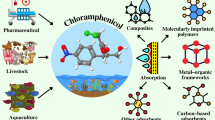Abstract
A quaternary ammonium type anion exchange resin with the N,N-dimethyldodecylbenzyl moiety as the functional group was synthesized and tested as a contact water disinfectant. The long chain alkyl groups are attached to a conventional polystyrene matrix with 2% divinylbenzene as a crosslinker which is insoluble and chemically stable. Suspensions containing up to a total of >109 live cells of the gram positiveBacillus subtilis were disinfected by passage through 1 ml beds of the polymer, Resin 12, at flow rates of 10 to 12 ml min−1 before any viable cells could be detected in the effluent. The disinfectant action increased with increasing temperature and was attributed to the intrinsic antimicrobial properties of the N,N-dimethyldodecylbenzyl function. The large disinfectant capacity and instant disinfection on contact may be understood as a consequence of the extremely high surface concentration of the quaternary functions on the resin beads and the strong hydrophobic effect driving the organisms toward the solution-resin interface. Resin 12 can be regenerated although the ethanolic HCL used in our experiments should be replaced by a less harsh regenerant for practical applications. The results obtained with Resin 12 are to be seen as the demonstration of a new approach to water disinfection using insoluble contact antimicrobials as an alternative to chlorination and other methods based on soluble, reactive agents.
Similar content being viewed by others
References
American Public Health Assoc.: 1965,Standard Methods for the Examination of Water and Wastewater, 12th ed., New York, N.Y., p. 586.
Augenstein, H. W.: 1974,J. Am. Water Works Assoc. 66, 716.
Bellar, T. A., Lichtenstein, J. J., and Kron, R.: 1974,J. Am. Water Works Assoc. 66, 703.
Dowty, B. J., Carlisle, D. R., and Laseter, J. C.: 1975,Environ. Sci. Tech. 9, 762.
Gregor, M. P., Noble, D., and Gottlieb, M. H.: 1955,J. Phys. Chem. 59, 10.
Harrigan, W. F. and McCance, M. E.: 1960,Laboratory Methods in Microbiology. Academic Press, New York, p. 15.
Helenius, A. and Simms, K.: 1975,Biochim. Biophys. Acta 415, 29.
Hugo, W. B. and Longworth, A. R.: 1966,J. Pharm. Pharmacol. 18, 569.
Jacobs, W. A., Heidelberg, M., and Amoss, H. L.: 1916,J. Exp. Med. 23, 569.
Kafzenelson, E., Kletter, B., and Shuval, H. J.: 1974,J. Am. Water Works Assoc. 66, 725.
Keller, J. W., Morin, R. A., and Shaffernorth, R.: 1974,J. Am. Water Works Assoc. 66, 730
Kessel, J. F. and Moore, F. J.: 1946,Am. J. Trop. Med. Hyg. 26, 345.
Klaassen, C. D. and Plaa, G.: 1967,Toxic and Appl. Pharm. 10, 119.
Kolthoff, I. M., Sandell, E. B., Meehan, E. J., and Bruckenstein, S.: 1969,Quantitative Chemical Analysis, 4th ed., Macmillan, New York, p. 798.
Lambert, J. L. and Fina, L. R.: 1975, U.S. Patent 3,923,665.
Lyne, C.: 1940,Microgiological Methods, University Park Press, Baltimore, p. 155.
McCarthy, J. J. and Smith, C. H.: 1974,J. Am. Water Works Assoc. 66, 718.
Mills, J. F.: 1975, U.S. Patent 3,462,363.
Nudel, R., Walfish, I. H., and other student participants: 1977, Final Summary Report of Student Summer Project, NSF-SOS 547A. Presented but not published.
Petrocci, A. N.: 1977, inDisinfection, Sterlization and Preservation, S. S. Block (ed.), 2nd ed., Lea and Febiger, Philadelphia, pp. 325–347.
Pryor, A. and Brown, R. S.: 1975,J. Environ. Health 37, 326.
Quisno, R. and Foter, M. J.: 1946,J. Bacteriol. 52, 111.
Shechmeister, I. L.: 1977, inDisinfection, Sterilization and Preservation, S. S. Block (ed.), 2nd ed., Lea and Febiger, Philadelphia, pp. 522–541.
Taylor, S. L., Fina, L. R., and Lambert, J. L.: 1970,Appl. Microbiol. 20, 721.
U.S. Environmental Protection Agency: 1975, ‘Preliminary Assessment of Suspected Carcinogens in Drinking Water’, Interim Report to Congress, Appendix VII, Health Effects Caused by Exposure to Contaminants, Washington, D.C.
Wang, L. K. and Peck, S. L.: 1973, ‘Improved Water Purification Tech.’, Calspan Report No. HJ-5293M2, Calspan Co., Buffalo, N.Y., 48 pp.
Wang, L. K. and Peery, G. G.: 1975,Water Res. Bull. 11, 919.
Author information
Authors and Affiliations
Rights and permissions
About this article
Cite this article
Walfish, I.H., Janauer, G.E. A new approach to water disinfection: I. N,N-dimethylalkylbenzyl-polystyrene anion exchange resins as contact disinfectants. Water Air Soil Pollut 12, 477–484 (1979). https://doi.org/10.1007/BF01046868
Received:
Revised:
Issue Date:
DOI: https://doi.org/10.1007/BF01046868




